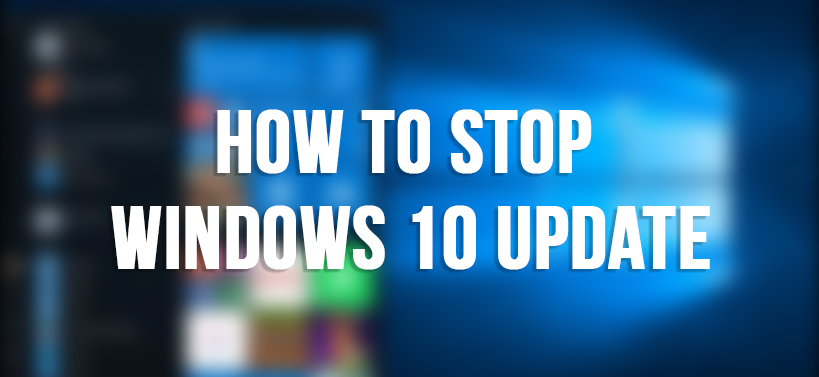Turn Off Windows 10 Updates Easily

Windows 10 updates itself quite frequently. There is a need to update the OS because it can patch any security flaws, increase performance and etc. The updates packages on Windows 10 OS are downloaded automatically in the background, whenever they are available. After that, when you restart the computer, next, the downloaded updates are installed.
Although this feature comes as a benefit for the users like you, even then, it can become a problem as the machine cannot be used unless and until the update process is complete. Due to this reason, many users like to turn off Windows 10 updates.
Solutions to disable Windows 10 Update
Here, you will get a plethora of methods, that will help you on how to stop Windows 10 update.
Limit the Network Connection
To ‘turn off automatic updates Windows 10’, get steps here to limit the network connection.
- First, click on the ‘Windows’ logo to open the ‘Start menu’. Inside that menu, go to the left pane and click on the ‘Gear’ icon right above the ‘Power’ icon.
- As soon as you click on that icon, then a new window with the title ‘Settings’ will come up. Within that window, there will be a variety of setting categories, that are specific for the Windows OS.
- Now, out of all those categories locate and choose the one that says “Network & Internet”. This action will open a new page, in it, go to the left pane and choose the “WiFi” option.
- Next, move to the right side and click on your wireless connection.
- At last, locate the “turn on Set as metered connection” option for the chosen WiFi network and click it to activate.
Deactivate the Windows Update Service
The Windows Update service is responsible for updating the Windows OS. Now, if you disable this service then you can halt updates to the Windows Operating System. Here are the steps on how can you do it.
- First, hit the ‘Windows + R’ keys together to open a new dialog box having the name ‘Run’ will come up.
- Within that dialog box, type the text “services.msc” beside the ‘Open’ label and then click on the ‘OK’ button.
- As soon as you click on that button, then a new window having the name ‘Services’ will appear. Inside that window, there will be a list full of all the services for every application present within the computer.
- From that list, move down a little then locate and double-click on the ‘Windows Update’ service. This opens a new dialog box having the title ‘Windows Update Properties (Local Computer)’ will come up.
- Inside that dialog box, go to the ‘Startup type:’ field and then choose the ‘Disabled’ option from the dropdown menu.
- At last, click on the ‘Apply’ and ‘OK’ buttons respectively to save any alterations to the computer.
Using Settings disable Automatic Updates
Here, you will get the process to deactivate the ‘Automatic Updates’ using the Settings application. Follow the steps below on disable Windows 10 update.
- First, press ‘Windows + I’ keys together to open the new ‘Settings’ window.
- Inside that window, locate and choose the ‘Update & Security’ category. This action will open a new page, in it, go to the left pane and choose the ‘Windows Update’ option.
- After that, move to the right pane of the page and then click on the ‘Advanced options’ button.
- As soon as you click on that button, then a new page will come up. Inside that page, go to the ‘Pause updates’ section.
- Under that section, locate the ‘Pause until’ field and then choose the time up to which you want to disable the automatic updates.
Utilize the Group Policy Editor to deactivate Automatic Updates
The Local Group Policy Editor can be used to disable the automatic updates of the Windows 10 OS permanently. In order to do that, follow the steps below.
- To open the default search area click on both the keys ‘Windows + S’ simultaneously.
- Next, within that area type in the text “gpedit.msc” and then from the results section choose the ‘Local Group Policy Editor’ option.
- As soon as you click on that option, then a new window having the title ‘Local Group Policy Editor’ will come up.
- Inside that window, go to the left pane and then follow the path to open the ‘Windows Update’ folder – “Computer Configuration\Administrative Templates\Windows Components\Windows Update”.
- Now, go to the right side of the window then find and double-click on the ‘Configure Automatic Updates’ option.
- When you click on that option, next, a new window with the heading ‘Configure Automatic Updates’ will come up. In it, select the ‘Disabled’ radio button to switch off this policy.
- Lastly, click on the ‘Apply’ and ‘OK’ button respectively.
How to turn off Windows 10 updates via Registry?
Here you will get another way to stop automatic updates of the Windows 10 Operating System using the registry. To do that effectively, follow the steps below.
- First, tap on the ‘Cortana logo’ to open the default search section of the Windows 10 OS. Within that section, type the text “registry editor” and then from the output of that search choose the ‘Registry Editor’ option.
- When you click on that option, next, a new window with the title ‘Registry Editor’ will come up.
- Inside that window, go to the left pane and double-click on every folder except the ‘Windows’ present within the following path – ”Computer\HKEY_LOCAL_MACHINE\SOFTWARE\Policies\Microsoft\Windows”
- Once you reach the ‘Windows’ folder, next, right-click on it and hover the mouse pointer over the ‘New’ option then choose the ‘Key’ sub-option.
- Give the name of the new key as ‘WindowsUpdate’ and hit ‘Enter’. Now, select and right-click on the ‘WindowsUpdate’ key. Next, from the popup menu again highlight the ‘New’ option and choose the ‘Key’ option.
- At this time, provide a name for the new key i.e ‘AU’ and tap on the ‘Enter’ button. Now, go to the right pane of the window then right-click on the blank area and select the ‘New’ option from a popup menu.
- After that, a sub-option menu will appear, from it click the ‘DWORD (32-bit) Value’ option.
- This will open a new dialog box, in it, provide a new name ‘NoAutoUpdate’ and then alter the number in the ‘Value’ field from ‘0’ to ‘1’.
- Finally, click on the ‘OK’ button and then reboot the machine.

 How to Solve GameStop Access Denied Error?
How to Solve GameStop Access Denied Error?  Solutions of the Error: Origin Friend Request not Working
Solutions of the Error: Origin Friend Request not Working  Fixed: Dragon Age Inquisition Opens then Closes
Fixed: Dragon Age Inquisition Opens then Closes  Guide to Enable On-Screen Keyboard on Windows 10 PC
Guide to Enable On-Screen Keyboard on Windows 10 PC  How to Perform Android File Transfer to Windows 10 PC?
How to Perform Android File Transfer to Windows 10 PC?  Install Snapchat for Windows 10 PC [Installation Guide]
Install Snapchat for Windows 10 PC [Installation Guide]